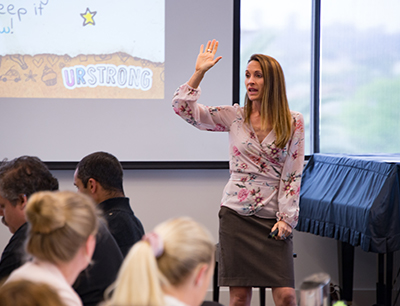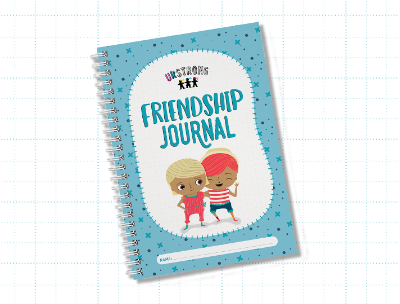“I Knew I Was Giving My Child Bad Advice, But I Didn’t Know What Else to Say!”
This is one of the most common things that parents have said to us over the years when it comes to friendship issues. And, we’ve heard from numerous children and educators who have shared some of the unhelpful or inappropriate advice well-meaning parents have given children.
When parents are activated by their child’s friendship issues (especially if someone has been cruel or malicious – what we call in our Friendology curriculum, “Mean-on-Purpose”), it is common for a parent’s protective instinct to kick in. This can trigger their FIGHT/FLIGHT/FREEZE/FAWN response, thanks to the autonomic nervous system. These default settings might sound like:
- FIGHT: “Just punch them back!”
- FLIGHT: “Go play with someone else!”
- FREEZE: “Ignore them!”
- FAWN: “Be friends with everyone!”
As we aim to support our children in fostering healthy relationships throughout their lives, it’s critical that parents understand how unhelpful and, in some cases, dangerous these stress responses can be for children.
A parent whose default setting is to FIGHT, teaches their child to respond to conflict with aggression and violence. Encouraging a child to get physical as a defence-mechanism immediately escalates the situation, activating anxiety in the child. Most children are not naturally aggressive and they know punching/pushing/pinching is wrong and will get them in trouble. When a parent tells a child to do something that is socially-unacceptable, it feels deeply confusing for them. Children are less likely to seek help from parents who promote fighting, often withholding information to avoid triggering anger in them. This is scary for children. Encouraging physical aggression is easily the most dangerous, trauma-inducing advice that can have serious long-term impacts.
A parent whose default setting is to FLIGHT, teaches their child to avoid conflict. This inevitably results in unhealthy friendships (and relationships) that lack trust and respect. When conflicts and frustrations are ignored, resentment builds and connections are fractured. A conflict-avoidant mindset prevents authenticity, transparency, and honesty in relationships. It limits the depth of a friendship and, for children, the friendship feels persistently in the Red-Zone on The Friend-o-Meter.
A parent whose default setting is to FREEZE, teaches their child to bottle their emotions. While ‘fight’ is exploding, ‘freeze’ is imploding. This approach teaches children to shut down, preventing them from processing their feelings. Research shows that repressing emotions amplifies them and can lead to feelings of anxiety. Children who keep their big feelings in often experience physical symptoms like stomach aches and trouble sleeping. Similar to avoiding conflict, healthy relationships are impossible when one person is unresponsive – relationships are a two-way street.
A parent whose default setting is to FAWN, teaches their child to be a people-pleaser. Fawning is when a child absorbs all the blame, overlooking their own feelings and doing whatever it takes to make the other person happy. According to Dr Rebecca Ray, “Fawning behaviours are common for people who experience significant levels of anxiety, and who identify as highly sensitive.” Children who fawn feel disempowered and often end up as the “door mat” in their friendships.
So, what can parents do instead to have a more helpful, socially-acceptable response?
CHECK-IN WITH YOURSELF
First, notice how you feel when your child shares their pain with you. Do you feel yourself reacting? Are you getting angry? Is it triggering something inside of you? Which of the 4 F’s can you feel yourself wanting to default to? The key is to remain calm and objective.
In the field of Positive Psychology, we love the famous Viktor Frankl quote: “Between stimulus and response there is a space. In that space is our power to choose our response. In our response lies our growth and our freedom.” This space that Dr Frankl describes is where empathy, compassion, and understanding can keep relationships in the Green-Zone on the Friend-o-Meter!
Just by being aware of how you’re feeling will allow you to be more mindful in how you respond to your child’s friendship issue.
FOCUS ON YOUR OWN CHILD
Second, focus on how YOUR child is feeling. Too often parents will focus on the other child (“I can’t believe they did that to you! What’s their problem? Why would they be like that?”), instead of their own.
Help your child name their emotions. Dr Dan Siegal coined the term “name it to tame it” – a very simple, effective technique that helps reduce the intensity of big feelings by labelling them.
Ask them, “How did that make you feel?” Give your child time and space to get their feelings out. Let them cry or be angry and JUST LISTEN. Offer a hug, go for a walk, play catch… Allow them a chance to get it out.
BE A FRIENDSHIP COACH
When you’re both in a calm state, it’s time to be a Friendship Coach and empower your child with evidence-based strategies.
If it was a Friendship Fire, encourage them to find a good time to talk to their friend. If it was Mean-on-Purpose, ask them: “Did you say your Quick Comeback?”
Check out this interactive tool (be sure to activate your FREE parent membership first!) where you can see the questions our URSTRONG Schools ask children when they experience conflict in friendship to coach them along.
Here are a few more resources that might help:
- Think of Yourself as a “Friendship Coach”
- When to Step-In and When to Step-Back
- High-Conflict Friendships
- 10 Reasons to NOT Call The Other Child’s Parents
- Boundaries: How to Use an Exit Strategy
Friendship skills are relationship skills! Teaching your child to manage conflict in a healthy way will help ensure they have positive relationships throughout their lives.
Written by: Dana Kerford
Founder & Friendship Expert








